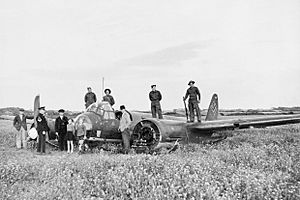Battle of Graveney Marsh facts for kids
Quick facts for kids Battle of Graveney Marsh |
|||||||
|---|---|---|---|---|---|---|---|
| Part of Battle of Britain | |||||||
 Another Junkers Ju 88A-1, following a crash landing in England in 1940 |
|||||||
|
|||||||
| Belligerents | |||||||
| Commanders and leaders | |||||||
| Captain John Cantopher | Unteroffizier Fritz Ruhlandt (POW) | ||||||
| Units involved | |||||||
| 1st Battalion, London Irish Rifles | Luftwaffe bomber crew | ||||||
| Strength | |||||||
| one company | four crew, armed with machine guns |
||||||
| Casualties and losses | |||||||
| none | four POW, including one wounded |
||||||
The Battle of Graveney Marsh happened on the night of September 27, 1940, in Kent, England. It was a small but important fight during World War II. This battle was the last time foreign soldiers fought on the ground in mainland Great Britain until a much later event called Operation Nimrod. The fight was between the crew of a German bomber plane that had been shot down and British soldiers from the 1st Battalion, London Irish Rifles.
Contents
What Happened at Graveney Marsh?
On that night, a German Junkers Ju 88A-1 bomber was flying over England. This plane was a new model and had only been used for about two weeks. British fighter pilots from 66 Squadron and 92 Squadron attacked the bomber. They were flying Hurricanes and Spitfires.
British pilots had been told to try and make German planes land safely if possible. This was so the planes and their crews could be captured. Capturing them helped the British learn about German technology and plans. The Ju 88 bomber already had one engine damaged by anti-aircraft fire during a raid on London. The fighter pilots then managed to destroy its other engine.
The German pilot, Fritz Ruhlandt, had to make an emergency landing. He brought the plane down in Graveney Marsh. Amazingly, all four crew members survived the crash landing.
The Fight Begins
Soldiers from the 1st Battalion, London Irish Rifles, were staying nearby in Seasalter. They quickly arrived at the crash site. The German airmen were trying to destroy secret equipment inside their plane. This was to stop the British from finding out their secrets.
Some reports say the Germans had machine guns from their plane and a smaller sub-machine gun. This smaller gun was part of a special survival kit given to German bomber crews. The British soldiers opened fire. One of the German crew members was hit in the foot. After this, the German crew gave up and were taken prisoner.
Later, the Royal Air Force (RAF) said that a fight did happen. However, they were not sure if the German crew fired at the British soldiers. They thought the Germans might have been shooting at their own plane to destroy it.
A Secret "Black Box"
During the event, Captain John Cantopher found a "black box" in the plane. One of the German prisoners said the plane might explode. Captain Cantopher quickly threw the box away from the plane into a ditch.
Some historians believe this "black box" was a secret German bombsight computer. The British government kept this incident quiet. They did not want Germany to know that their secret equipment had been found.
Why Was This Battle Important?
The Battle of Graveney Marsh was important for a few reasons:
- It was the last time foreign soldiers fought on the ground in mainland Britain for many years.
- The captured German plane gave the British very useful information. It helped them understand German aircraft technology better.
- Captain John Cantopher was given the George Medal for his brave actions. This medal is awarded for acts of great bravery.
The captured German bomber was taken to Farnborough Airfield. Experts there examined it closely. They said it "provided highly valuable information."
Remembering the Battle
In September 2010, the London Irish Rifles Regimental Association put up a special plaque. This plaque was placed at the Sportsman pub in Seasalter. It marked 70 years since the Battle of Graveney Marsh and honored the soldiers involved.

